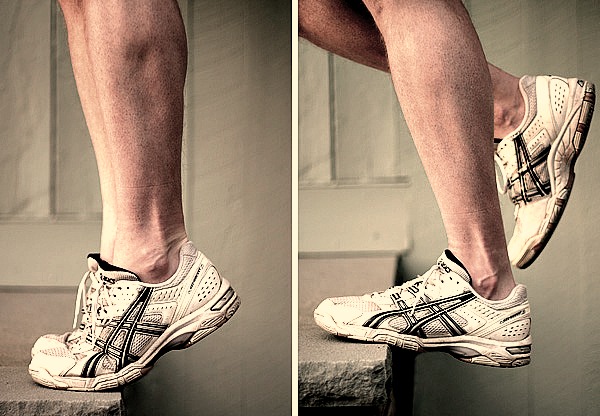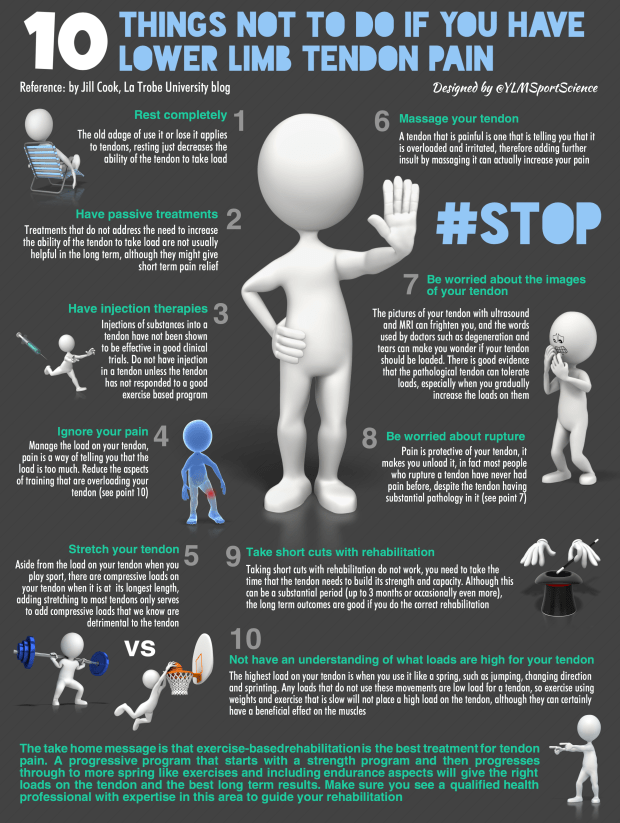We love a good infographic, and recently came across this great one from @YLMSportsScience – 10 Things NOT To Do If You Have Lower Limb Tendon Pain.
Tendon pain in the lower limb, and tendinopathies are one of the most common type of injuries we see in our clinics. The most common are Achilles tendinopathy and patella tendinopathy (jumper’s knee). It’s a side effect of having a pretty active, local population who regularly take part in exercise to help keep them healthy.
What should you be doing (or not)?
Tendon pain can be really frustrating to have. Firstly, because it often affects those that are naturally more active or sporty, so has a huge impact on being able to do what you love to do. Secondly, it can be difficult to know what to do for the best. There’s a lot of conflicting information out there, and can be a bit of trial and error to find the right solution and have a successful recovery. This infographic, which illustrates great, evidence-based principles on managing such issues, offers some extremely useful guidance.
The 10 Rules
- Do not rest completely. We prefer the term ‘relative rest’. Avoid activities that directly aggravate your pain, but keep going with others or find alternatives. It’s important to carry on ‘loading’ (so getting your tendon to work) to help your recovery.
- Do not rely on ‘passive’ treatments. There is overwhelming evidence that passive treatments (so something that’s just done to you, whilst you lay there happily!) alone will not help with tendon problems. They can be useful in relieving your pain in the short term, enabling you to do some more specific exercises though.
- Do not have injection therapy. This advice refers to having an injection as the first line of treatment. If you’ve tried a consistent, high quality, exercise based treatment plan and it hasn’t worked, then injection therapy may be indicated.
- Do not ignore your pain. Just like number 1, use your pain level as a guide for your activity. Pain in your tendon is your body’s way of telling you it can’t really cope and you need to listen to it!
- Do not stretch your tendon. When you place your tendon on stretch, the lengthening action also compresses the tendon and this has been shown to affect recovery. There are alternative exercises to stretching that are significantly more beneficial to you.
- Do not massage your tendon. If it’s painful, it’s irritated. Massaging directly on the tendon is likely to cause further irritation and make the pain worse.
- Do not be worried about images of your tendon. Try not to have a picture in your mind of what your painful tendon might look like on an ultrasound or MRI scan. Words like ‘degeneration’ or ‘tears’ can make you afraid of using your tendon. Actually, gradually building up what you do and with guided, appropriate rehabilitation is the best way of recovering.
- Do not be worried about rupture. Reassuringly, most people who rupture their tendon have not had any pain. Because you have pain, you are naturally easing off what you do, so you really don’t need to worry about the risk of rupturing your tendon.
- Don’t take short cuts with rehabilitation. It takes time for an injured tendon to build strength and capacity (ability to cope with the demands you place upon it). There are no quick, easy fixes unfortunately! With the right rehab, outcomes are excellent. We can provide you with a customised, specific, evidence based rehabilitation programme that will give you the best outcomes.
- Do not have a lack of understanding of what loads are right for your tendon. This is crucial but not an easy concept for non-therapist to understand fully. Gradually loading your tendon to optimise recovery is fundamental. What you should be doing and when can take careful management. Sometimes the internet or a well meaning friend aren’t fully qualified or experienced enough to help you with this. You need to call in the experts, and that’ where we come in.
What is load?
If you read anything ‘rehab’ based about tendons, you will often hear the term LOAD and may be thinking what exactly does that mean?
Load can be simplified as the demands that you place upon your body. For example, if you take your Achilles tendon, when you walk you are loading it. But, when running you are loading it more, and jumping even more. If you go on your tip toes, you’ll be loading it. If you’re holding a weight whilst going up and down on your tip toes, you’ll be loading it even more.
Loading can be varied by weight, duration, number of times or how long you do something for, how high impact you are working at. Your rehab should be based on what load your tendon can tolerate.
What next?
If you are suffering with a tendon problem, don’t waste any more time or prolong your frustration. Seek expert advise. We can offer you a full package of support, with as little or as much ‘hand holding’ as you need.
Give us a call on 01745 434432 to book your first appointment.







